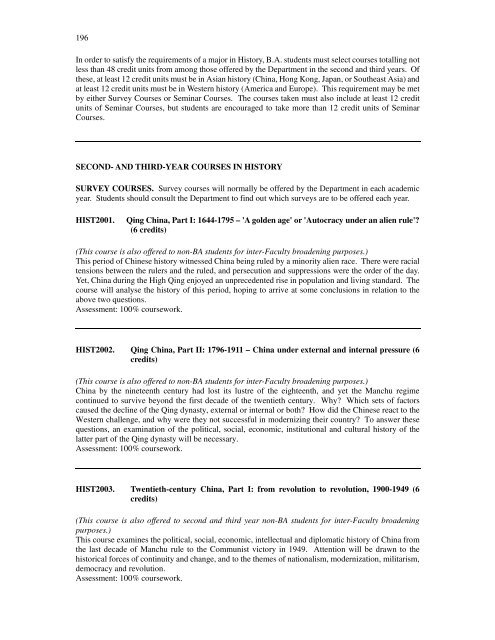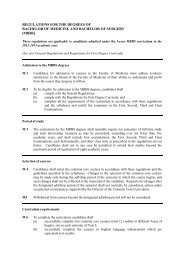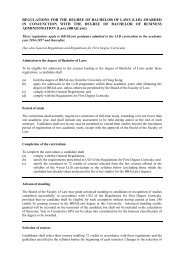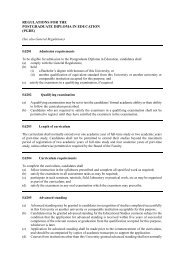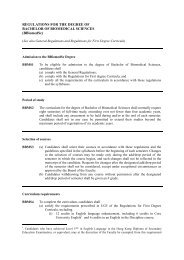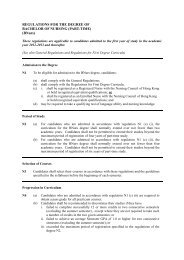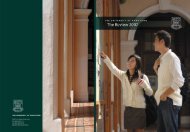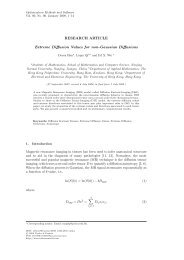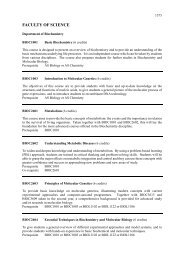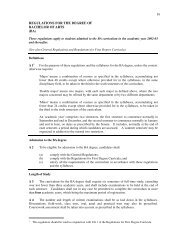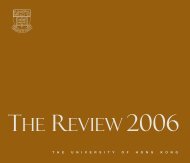Bachelor of Arts (BA) - The University of Hong Kong
Bachelor of Arts (BA) - The University of Hong Kong
Bachelor of Arts (BA) - The University of Hong Kong
You also want an ePaper? Increase the reach of your titles
YUMPU automatically turns print PDFs into web optimized ePapers that Google loves.
196In order to satisfy the requirements <strong>of</strong> a major in History, B.A. students must select courses totalling notless than 48 credit units from among those <strong>of</strong>fered by the Department in the second and third years. Ofthese, at least 12 credit units must be in Asian history (China, <strong>Hong</strong> <strong>Kong</strong>, Japan, or Southeast Asia) andat least 12 credit units must be in Western history (America and Europe). This requirement may be metby either Survey Courses or Seminar Courses. <strong>The</strong> courses taken must also include at least 12 creditunits <strong>of</strong> Seminar Courses, but students are encouraged to take more than 12 credit units <strong>of</strong> SeminarCourses.SECOND- AND THIRD-YEAR COURSES IN HISTORYSURVEY COURSES. Survey courses will normally be <strong>of</strong>fered by the Department in each academicyear. Students should consult the Department to find out which surveys are to be <strong>of</strong>fered each year.HIST2001.Qing China, Part I: 1644-1795 – 'A golden age' or 'Autocracy under an alien rule'?(6 credits)(This course is also <strong>of</strong>fered to non-<strong>BA</strong> students for inter-Faculty broadening purposes.)This period <strong>of</strong> Chinese history witnessed China being ruled by a minority alien race. <strong>The</strong>re were racialtensions between the rulers and the ruled, and persecution and suppressions were the order <strong>of</strong> the day.Yet, China during the High Qing enjoyed an unprecedented rise in population and living standard. <strong>The</strong>course will analyse the history <strong>of</strong> this period, hoping to arrive at some conclusions in relation to theabove two questions.Assessment: 100% coursework.HIST2002. Qing China, Part II: 1796-1911 – China under external and internal pressure (6credits)(This course is also <strong>of</strong>fered to non-<strong>BA</strong> students for inter-Faculty broadening purposes.)China by the nineteenth century had lost its lustre <strong>of</strong> the eighteenth, and yet the Manchu regimecontinued to survive beyond the first decade <strong>of</strong> the twentieth century. Why? Which sets <strong>of</strong> factorscaused the decline <strong>of</strong> the Qing dynasty, external or internal or both? How did the Chinese react to theWestern challenge, and why were they not successful in modernizing their country? To answer thesequestions, an examination <strong>of</strong> the political, social, economic, institutional and cultural history <strong>of</strong> thelatter part <strong>of</strong> the Qing dynasty will be necessary.Assessment: 100% coursework.HIST2003. Twentieth-century China, Part I: from revolution to revolution, 1900-1949 (6credits)(This course is also <strong>of</strong>fered to second and third year non-<strong>BA</strong> students for inter-Faculty broadeningpurposes.)This course examines the political, social, economic, intellectual and diplomatic history <strong>of</strong> China fromthe last decade <strong>of</strong> Manchu rule to the Communist victory in 1949. Attention will be drawn to thehistorical forces <strong>of</strong> continuity and change, and to the themes <strong>of</strong> nationalism, modernization, militarism,democracy and revolution.Assessment: 100% coursework.


